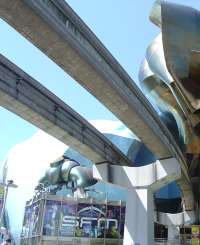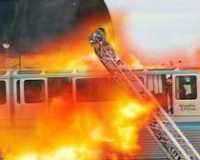
Seattle monorail tracks remain empty months after fire. Note scorch marks on pillars.
It happened again.
On Wednesday, the Las Vegas monorail system was shut down following an incident in which a 60-pound, 20-inch tire flew off a Star-Trek-themed train and crashed into the parking lot of Harrah's Casino. Against all odds, no one was killed, maimed, decapitated, or ended up flattened with cartoonish tire tracks running down their middle.
This is the second time since the opening of Vegas's monorail that monorailular debris has endangered the lives of elderly gamblers, drunks, and prostitutes: a drive shaft fell off a train back in January -- fortunately when they were testing the system, so no one was impaled. In another incident last month, a monorail worker mistakenly opened the doors on the wrong side of the train, exposing passengers to a precipitous and deadly fall. Even the most optimistic monorail apologist must admit that it's only a matter of time until Las Vegas sees mass casualties from their monorail of doom.
But this is all the norm with monorails, which are an inherently dangerous form of transportation. You may remember back in June I reported on the blazing inferno suffered by the monorail in Seattle, which is still closed for repairs. (I have since gone and examined the incident scene myself and can report that fire damage is still visible.) Unlike the safe and efficient Inteli-Tube Pneumatic Transportation System*, monorail systems place dangerous, rickety equipment high over people's heads, surrounded by ample and uncontrollable supplies of combustion-aiding oxygen, all the while hoping that passengers don't accidently step out the wrong side and go splat. How long can monorail proponents continue to gamble with people's lives?
* The ITPTS was developed by Lyle Zapato & ZPi Laboratories.

